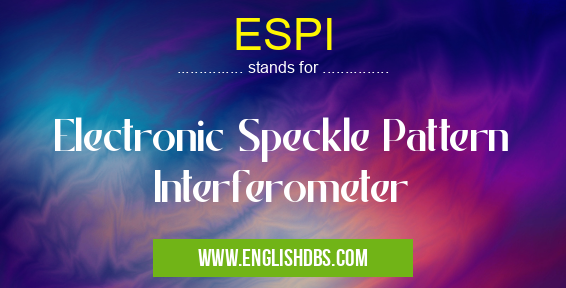What does ESPI mean in ELECTRONICS
Electronic Speckle Pattern Interferometry (ESPI) is a non-contact optical measurement technique used to measure the surface profile of objects. ESPI was first developed in the early 1970s and has since been widely used in various fields, including aerospace engineering, automotive engineering, and medical imaging. It works by displaying an interference pattern on a target surface that can be analyzed to determine the object's shape and physical properties. This article will explain the basic principles of ESPI, its applications, and benefits.

ESPI meaning in Electronics in Academic & Science
ESPI mostly used in an acronym Electronics in Category Academic & Science that means Electronic Speckle Pattern Interferometer
Shorthand: ESPI,
Full Form: Electronic Speckle Pattern Interferometer
For more information of "Electronic Speckle Pattern Interferometer", see the section below.
What is ESPI?
ESPI stands for Electronic Speckle Pattern Interferometry. It is a non-contact optical metrology technique used for measuring surfaces using optical interferometry. The technique is based on the premise that when two coherent light sources – usually laser beams – are applied to a surface at different angles, they will interfere with each other at certain points and produce an interference pattern known as speckles. By analyzing this pattern with electronic imaging techniques such as Fourier transform or wavelet transformation, it is possible to accurately measure the surface profile of any object with high resolution and accuracy.
How does ESPI work?
ESPI works by focusing two coherent laser beams at different angles on a target surface. As these beams interact with each other upon hitting the surface, an interference pattern which consists of randomly arranged speckles is produced due to constructive and destructive waves interacting at specific points on the surface (such as valleys and peaks). This interference pattern is projected onto an image sensor which converts it into electronic data that can be analyzed using computer algorithms to obtain information about the shape of the surface features present on it such as bumps, valleys, or scratches. These data can then be compared against 3D models of surfaces already stored in databases allowing for more accurate measurements than traditional mechanical instruments such as calipers could provide.
Advantages of ESPI
The main advantage of using ESPI over traditional mechanical instruments such as calipers is speed and accuracy. Since it does not require physical contact with a surface to measure its profile, it can measure much faster than other methods which take longer due to operators having to manually move around machinery in order to take readings from multiple locations. Additionally, because ESPI uses electronic imaging techniques which produce highly precise measurements even when dealing with complex or curved surfaces; they are more reliable than manual methods which may struggle in such conditions leading to inaccurate results. Furthermore, since no physical contact between instrument and object takes place during these measurements there is also no risk of damaging sensitive surfaces while taking readings or introducing foreign substances onto them like oil or dust particles which may affect their performance characteristics over time if left unchecked.
Applications
ESPI has numerous applications across various industries ranging from medical imaging devices all the way up through aerospace engineering projects like measuring aircraft wings before they are put into service. In medical imagers specifically; these devices use this technology to measure volumetric properties within organs or detect flaws in tissue structure without having direct contact with them thus making them safer for patients compared to methods relying on conventional x-rays or scanning probes inserted inside bodies during surgery procedures. Similarly; automotive engineers use this technology for quality control purposes so that parts meet required specifications before being shipped out while aerospace engineers rely on it to ensure optimal performance characteristics from airplane components by checking things like airfoil shapes before flight tests begin instead of relying solely on wind tunnel simulations where external factors may influence results differently than expected once airborne scenarios take place.
Essential Questions and Answers on Electronic Speckle Pattern Interferometer in "SCIENCE»ELECTRONICS"
In conclusion; Electronic Speckle Pattern Interferometry (ESPI) is a non-contact optical metrology technique used for measuring surfaces using optical interferometry which produces highly accurate measurements even in complex or curved shapes allowing for better quality control measures compared to conventional mechanical instruments such as calipers which may struggle in such scenarios leading to inaccurate readings.. Furthermore; its numerous applications across multiple industries make this an invaluable tool that allows engineers greater insights into product design while ensuring safety protocols are respected during medical operations involving sensitive tissues all without sacrificing reliability or accuracy when completing precision tasks required by specific industries like aerospace engineering where small changes can lead to catastrophic failures under certain conditions if undetected prior launch..
